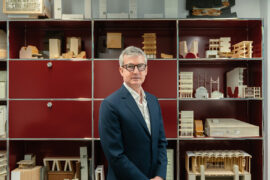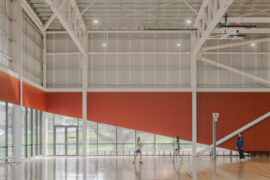The ‘alpha generation’ has never known a world without smartphones. How do we design early learning environments to nurture these digital natives on their own, new-age terms?
December 3rd, 2019
Designing learning environments for preschoolers and primary aged children is no easy task. Not only does their attention have to be captured, but it also needs to be held for extended periods of time. Today’s next-generation learner (popularly termed, ‘alpha generation’) makes it all the more challenging for educators because they’ve grown up with smart, rapidly developing technology. These kids are inquisitive problem solvers and creative thinkers. So where do we even begin?
We know that the most successful learning environments for children are highly interactive to encourage physical as well as digital connection. Such spaces are invested with a degree of flexibility to better personalise the experience because current pedagogies acknowledge learning is different for each student.
Indeed, using any number of highly regarded pedagogical approaches, either singularly or in combination, as the foundation upon which to build a design’s concept, is a logical starting point. And this is where the Reggio Emilia approach (named for the region in Italy where it was developed after World War II) comes in. It’s a popular educational philosophy and one which design practices have successfully employed both in Australia and abroad. Not surprising, architects tend to gravitate towards its theories in which environment is crucial, often being referred to as the ‘third teacher’.
For Rome-based studio Labics, it served as the conceptual underpinning for the Jacaranda nursery and kindergarten in Milan. This is an adaptive re-use project impressive for its existing concrete structure and the vision of the architects and their consultants, the Reggio Children Foundation, in reimagining it.
Formerly a garage, the new fit-out takes advantage of the expansive interior by positioning a double-height atrium at its centre. A piazza-like space is pertinent to the Reggio Emilia philosophy and in this case, it’s essential to facilitating a sense of community, with a view to building children’s interpersonal skills. It’s also the heart of the facility from where horizontal and vertical paths extend, enabling connection with surrounding classrooms.
The use of glazing to partition the classrooms adds to the open plan nature of the space, with a series of curved freestanding storage/divider systems enabling flexible configuration of spaces in the ground-level kindergarten. As Labics co-founders Maria Claudia Clemente and Francesco Isidori explain in regards to the project’s planning: “It’s necessary to conceive environments that are capable of stimulating an active interpretation of space. We need to imagine places that are experiential and as open as possible to different uses for growth and interaction to happen.”
The fact this space is so light and airy makes it a conducive learning environment and the architects have been mindful to not clutter it, reiterating an Emilia Reggio strategy that spaces should be kept open and connected to nature without being overstimulating to children. This makes Labics’ use of colour even more effective, as the majority of the palette is applied to the ceiling, with judicious pops of lime green, pink and blue at ground and mezzanine levels.
The children are seemingly enveloped by a rainbow, but because the teaching takes place at their scale, they’re never distracted. Aesthetically, it allows the cavernous white space to playfully avoid a stark whitewashing.
Certainly, interaction with the physical environment is key to developing children’s soft skills. In the Margaret Cribb Early Learning Centre (MCELC) at the University of Queensland, dwp has designed an exceptional facility that likewise does this by encouraging discovery. “It’s based on the idea of a soft shell, so every part of the community-focused design has a relation to the heart of the scheme – the landscaping and outdoor play space – hence the building’s horseshoe-shaped plan,” says dwp’s design director, David Brian.
The MCELC is a fine Australian application of the Reggio Emilia approach and just like Labics’ Jacaranda, its internal spaces are arranged for flexibility, with different settings that allow for various levels of mental concentration throughout the day. It treats the outdoor play space as a piazza and the children’s connection to nature in this instance is pertinent for self-guided learning. To a degree, they have no boundaries and are free to explore, mixing with all age groups and experiencing a diversity of areas (with supervision), from the veggie patch and chicken house to amphitheatre.
This is biophilic design at its best and Brian and team have worked with the sub-tropical climate to ensure the interior is well-ventilated and receives plenty of natural light via strategically placed openings. “Beyond that connection to the outdoors, it’s also about highly tactile surfaces and the various textures of the material palette,” explains Brian. “There was a big push to create an openness that a lot of childcare centres don’t have and to also ensure the outcome wasn’t bland.”
The windows’ angular forms and the building’s robust cladding definitely make it stand out from its surrounds, although it’s still very much embedded in its context.
If design can play a positive role in raising the next generation learner, then it needs to be as inclusive, dynamic and engaging as both these projects to offer a counterpoint in this high-tech world.
This article originally appeared in issue #77 of Indesign magazine – the ‘Knowledge Economy’ issue. Get regular updates to your inbox, join our mailing list.
INDESIGN is on instagram
Follow @indesignlive
A searchable and comprehensive guide for specifying leading products and their suppliers
Keep up to date with the latest and greatest from our industry BFF's!

The undeniable thread connecting Herman Miller and Knoll’s design legacies across the decades now finds its profound physical embodiment at MillerKnoll’s new Design Yard Archives.

Welcomed to the Australian design scene in 2024, Kokuyo is set to redefine collaboration, bringing its unique blend of colour and function to individuals and corporations, designed to be used Any Way!

Leading by design, Erik L’Heureux has recently taken the helm of Monash University’s Department of Architecture, and so a new and exciting journey begins for both L’Heureux and the University.

Joan Montgomery Centre PLC by Warren and Mahoney is a tour de force of education design, with high-end facilities including a swimming pool and general athletic amenities.
The internet never sleeps! Here's the stuff you might have missed

Dr Piers Taylor – award-winning British architect, BBC presenter and founder of Invisible Studio – returns to Australia to deliver a keynote at the inaugural Glenn Murcutt Symposium.

Karndean’s newly evolved Opus range brings versatility and durability to the forefront of commercial flooring. Blending design-led aesthetics with robust, high-performance functionality, it’s a go-to solution for spaces that demand both style and resilience.